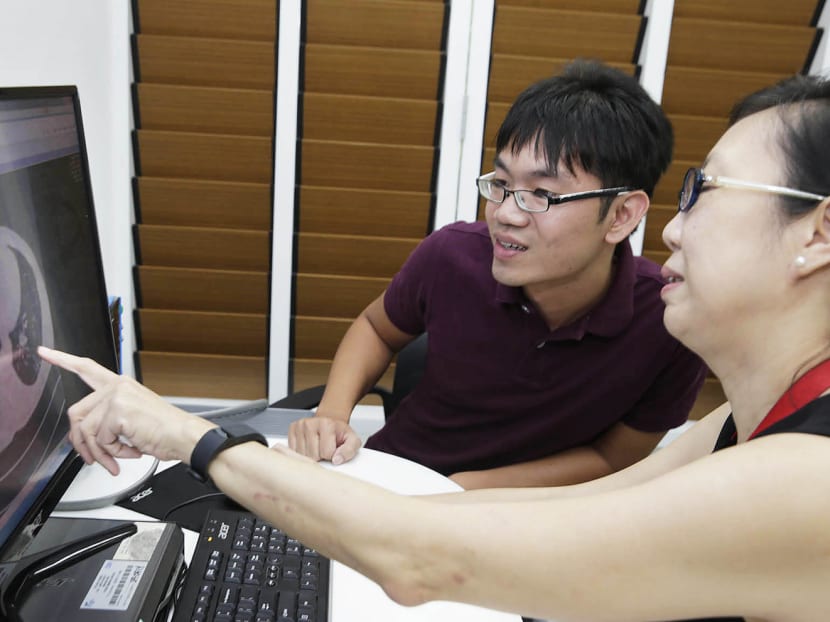Tuberculosis patients need support but are often shunned, stigmatised
SINGAPORE — While other tuberculosis (TB) patients struggle with social stigma, Mr Sum Zhan Seng, 28, counts himself fortunate to have had the support of family and friends while undergoing treatment for the disease last year.

Unlike some TB sufferers, when Mr Sum Zhan Seng was diagnosed with the disease, his family and friends provided much-needed support. Photo: Wee Teck Hian/TODAY
SINGAPORE — While other tuberculosis (TB) patients struggle with social stigma, Mr Sum Zhan Seng, 28, counts himself fortunate to have had the support of family and friends while undergoing treatment for the disease last year.
His condition had gone undetected for months despite consulting three general practitioners and undergoing two chest X-rays.
Besides having a persistent cough, he had coughed out blood and experienced “an achy pain” in the lungs.
Mr Sum was diagnosed by a specialist at Tan Tock Seng Hospital (TTSH).
“At that point, a TB diagnosis was actually a relief to me as the doctor had mentioned a possibility of lung cancer. I felt that way because TB is no longer a death sentence with early treatment,” he said.
Concerned that he might have unknowingly spread the disease, Mr Sum told his friends and family about his diagnosis.
“However, no one seemed very worried (about catching TB). Instead, they all told me to get well soon. During my treatment, I met so many people who did not avoid me but supported and encouraged me. They see TB as an illness that can be treated and cured,” said Mr Sum, sharing his experience ahead of World TB Day tomorrow.
TB is caused by the bacterium Mycobacterium tuberculosis, which can be transmitted through respiratory droplets from an infected person.
While TB mostly affects the lungs, it can also affect other parts of the body, including the brain, spine and eyes.
STIGMA, LACK OF SUPPORT
Not every TB sufferer enjoys the same social support as Mr Sum.
Despite completing a six-month-long treatment for TB, 46-year-old production worker Alice Lim (not her real name) is fearful of letting her colleagues and friends know that she contracted the disease last year. Her husband also suffered a bout of TB in 2014.
“Our neighbours did not dare let their kids come near us. Whenever they saw us, they would walk away as if they had seen a ghost. How can I possibly tell anyone at work about my condition?” said Mdm Lim.
Misconceptions about TB, which stem from a lack of knowledge and awareness about how the disease is spread, mean that many patients experience social isolation during their treatment, said Ms Chiam Ai Ling, senior medical social worker at Tuberculosis Control Unit (TBCU) at TTSH, which treats about 2,000 patients each year, or about three quarters of all TB cases in Singapore.
A common misconception about TB is that patients remain infectious even with treatment, said Ms Chiam.
Once treatment starts, a TB patient is much less infectious than he or she was before treatment, according to Dr Cynthia Chee, senior consultant at TBCU.
Patients are given medical leave during the initial two weeks of treatment as a precautionary measure to prevent further spread of the disease to the community.
They are considered non-infectious after the first two weeks of treatment, said Dr Chee.
“Because of the stigma, some patients have difficulties finding employment as potential employers fear transmission of the disease in the workplace. Others face stigma when friends or family minimise social contact with them for fear of contracting TB,” said Ms Chiam.
This can make it difficult for them to complete their treatment successfully, in turn perpetuating the transmission of the disease, she added.
TREATMENT LASTS six to nine months
Treatment for the disease lasts at least six months, with some cases stretching to nine months.
In Singapore, patients under the National TB Programme undergo Directly Observed Therapy (DOT), where medication is administered under supervision at the polyclinic nearest to the patient.
“While patients generally feel better after the first one to two months of treatment, they still need to complete the entire course of treatment to prevent a future relapse. If they do not take their medications properly, they may also develop drug resistance,” said Dr Chee.
Despite the availability of effective treatment, TB overtook the human immunodeficiency virus (HIV) as the top infectious disease killer worldwide in 2014.
In the same year in Singapore, close to 3,000 people were diagnosed with TB and 55 people died from it, according to figures from the Ministry of Health website.
“TB can kill when it is diagnosed at an advanced stage and treatment is delayed, so it is important to detect and treat the condition early,” said Dr Chee.
Mr Sum decided to share his experience to destigmatise the disease and encourage other patients to adhere to their treatment.
“For TB patients facing stigma, hang in there. With treatment, this is an illness that you can recover from,” he said.






